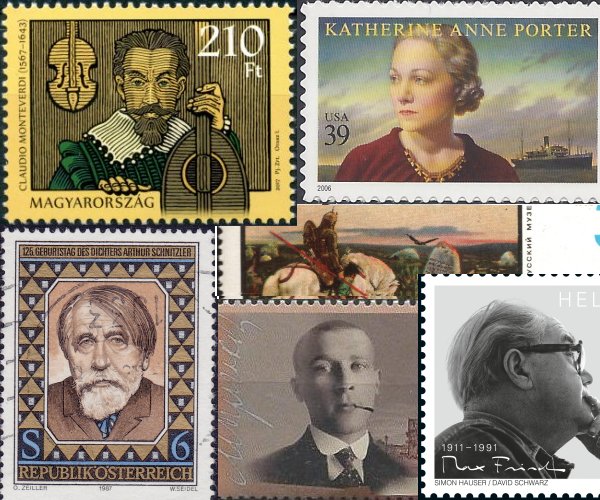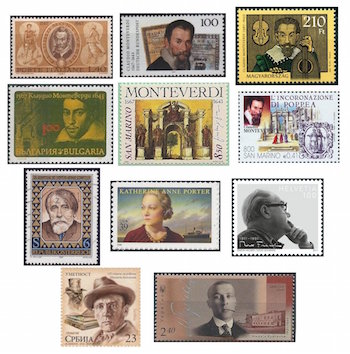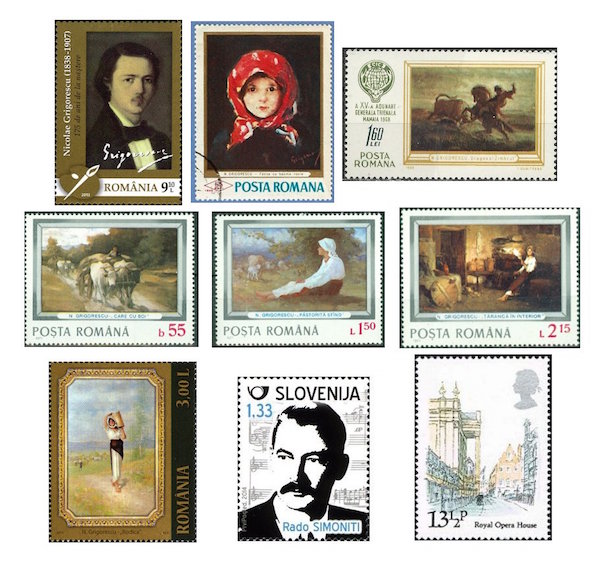The Arts on the Stamps of the World — May 15
An Arts Fuse regular feature: the arts on stamps of the world.

By Doug Briscoe
Today we celebrate the 450th anniversary of the birth Claudio Monteverdi, and we have no fewer than four genuinely great novelists (and a fifth, hugely popular one), three painters, and another composer to deal with.
One of my well-informed radio listeners once opined that the three greatest composers in terms of innovation were Monteverdi, Beethoven, and Stravinsky. Born at Cremona, Monteverdi (baptized 15 May 1567) bridged the Renaissance and Baroque eras, as can be seen, perhaps most clearly, in his nine great books of madrigals, the earliest from 1587, the last published posthumously in 1651. His other two areas of concentration were in sacred music and opera, of which he wrote one of the earliest, Orfeo, in 1607. He was active in Mantua, Rome, and for the last thirty years of his life, Venice, where he died on 29 November 1643. Given the numerical significance of the anniversary, I rather expected to see a fair number of new Monteverdi stamp issues this year, but the only one I know of is from Hungary (upper right).
Remarkable—isn’t it?—that four such stellar writing talents as Arthur Schnitzler, Katherine Anne Porter, Mikhail Bulgakov, and Max Frisch should share a birthday, along with the creator of The Wonderful Wizard of Oz, L. Frank Baum!
Austrian-Jewish author and medical doctor Arthur Schnitzler (15 May 1862 – 21 October 1931) composed only three full-length novels, but wrote more by way of short stories, novellas, and plays, most of them having sexual themes daring for their time. His stamp came out in 1987.

Katherine Anne Porter (May 15, 1890 – September 18, 1980) also excelled at short fiction and indeed won a Pulitzer for her 1965 Collected Stories; her only novel was Ship of Fools (1962, made into a film with a golden cast—Vivien Leigh, José Ferrer, Lee Marvin, Simone Signoret, Oskar Werner, and the wonderful and overlooked Michael Dunn—in 1965). The Porter stamp was issued in 2006.
I position the centenary stamp for Swiss novelist and playwright Max Frisch ahead of Mikhail Bulgakov’s purely for visually aesthetic considerations. Bulgakov (15 May [O.S. 3 May] 1891 – 10 March 1940) was born twenty years ahead of Frisch. Like Schnitzler, he was also a physician. His work was introduced to me in college, where I read his most striking novel The Master and Margarita. (Years later I read it again.) The cat in the top hat on the Serbian stamp is a reference to the novel, which has elements of fantasy. Both it and the broad stamp from Ukraine were issued last year for the 125th anniversary of the writer’s birth.
Max Frisch (May 15, 1911 – April 4, 1991) aspired from a young age to be a writer but also went into architecture like his father. In that capacity he built two private homes and a public swimming pool, otherwise concentrating mostly on his writing. There are ten novels and fourteen plays.
L(yman) Frank Baum (May 15, 1856 – May 6, 1919) also wrote plays—and acted in them—as well as dozens of novels besides The Wonderful Wizard of Oz (1900) and its thirteen sequels. (The series was continued after his death with a further nineteen books by Ruth Plumly Thompson.) Baum was remarkably prescient in his imaginings of future technologies, anticipating television, laptops, and wireless telephones. The only related stamp issued by the United States celebrates more the 1937 movie and Judy Garland than Baum himself, who is nicely represented on a couple of souvenir sheets from the Gambia.

Now to our three painters. On this day in 1461 Domenico Veneziano, who was born some time around 1410, died at Florence. His name would suggest that he was born in Venice, but from an early age he was apprenticed to Gentile da Fabriano in Florence, where he created the Santa Lucia de’ Magnoli Altarpiece (c1445–1447), a detail of which is shown on the Italian stamp of 2004, issued not to commemorate Veneziano, but rather the 1700th anniversary of the martyrdom of Saint Lucy. Veneziano was also active in Perugia and Tuscany. An assistant of his at one point was Piero della Francesca.
As you can see, there are many stamps, mostly Russian ones, for painter Viktor Vasnetsov (May 15, 1848 – July 23, 1926), who even designed one himself, but more about that in a moment. In 1951 he was honored on a pair of stamps with his portrait and his 1898 mythological piece Bogatyrs. Another of his best known works, A Knight at the Crossroads (1882), graces a large Soviet stamp of 1968. Fast forward to 1998 for the triptych of two stamps of Fight of Scythians and Slavs (1881) and Ivan Tsarevich Riding the Grey Wolf (1889) on either side of a label that offers Vasnetsov’s 1873 Self-portrait. The Flying Carpet (1880) shows up on a stamp from the Solomon Islands, and one showing the artist’s home and museum came out in 2015. Now, about that stamp that Vasnetsov designed: it’s not for postage, but rather a revenue stamp he was asked to design in 1914. It’s placed last in our collage. By the way, Vasnetsov’s brother Apollinary was also a painter, and we’ll see his stamps on July 25th when his birthday comes around.
As an apprentice, Nicolae Grigorescu (15 May 1838 – 21 July 1907) painted icons for a church and a monastery. He advanced to the stage that he earned a scholarship for study at the École des Beaux-Arts in Paris, where one of his classmates was Renoir. Subsequently he also came to know Millet, Corot, and Courbet. Besides visits home, his travels took him to Italy, Greece, and Vienna. All of Grigorescu’s stamps come from his native Romania: Self-Portrait is the most recent (2013), followed by Little Girl with Red Kerchief, Prince Dragos and Wisent, and three more pictures, Ox-Cart, Shepherdess, and Woman Spinning with Distaff, from a 1976 set of a half dozen Grigorescu issues. In the bottom row another recent stamp from 2011, Rodica.

The Slovenian composer and conductor Rado Simoniti was born on this date in 1914. At first a teacher, he was conductor of the Slovenian National Theater in Ljubljana during the war, until joining the partisans in 1943. The robo-translations of two articles on Simoniti are unclear to me, but it seems he conducted a partisan choir with whom he traveled throughout the region. After the war, he was conductor of the Ljubljana Opera and Slovenian Philharmonic Orchestra. He died on the day before his 67th birthday in 1981. His 600 compositions include many choruses, a number of them for the partisans, and songs for voice and piano. There is even a partisan opera called Partizanka Ana (1966).
On this date in 1858 the current incarnation of the Royal Opera House in Covent Garden opened. The original was The Theatre Royal, which had been in existence since 1732. (The opening production on that occasion was of Congreve’s The Way of the World. The first opera to be presented there was Handel’s Il pastor fido in 1734. Fire claimed both that building (1809) and its successor (1856), bringing us to the modern edifice constructed by the brothers Charles and Thomas Lucas. Opening night featured a performance of Meyerbeer’s opera Les Huguenots. The House didn’t become Royal until 1892.
Happy birthday to American abstract expressionist artist Jasper Johns (born May 15, 1930).
A graduate of the University of Massachusetts with a B.A. in English, Doug Briscoe worked in Boston classical music radio, at WCRB, WGBH, and WBUR, for about 25 years, beginning in 1977. He has the curious distinction of having succeeded Robert J. Lurtsema twice, first as host of WGBH’s weekday morning classical music program in 1993, then as host of the weekend program when Robert J.’s health failed in 2000. Doug also wrote liner notes for several of the late Gunther Schuller’s GM Recordings releases as well as program notes for the Boston Classical Orchestra. For the past few years he’s been posting a Facebook “blog” of classical music on stamps of the world, which has now been expanded to encompass all the arts for The Arts Fuse.
